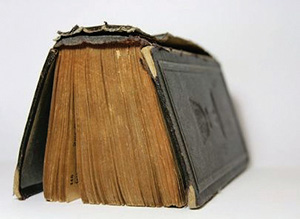
There comes a time in every sefer’s life when you ask, “Should I bind this?” Except with bentchers. I guess staples hold.
For some people, this time comes right away. They buy the sefer and they bind it.
I’m sure the publishers are glad that they put so much work into making seforim with beautiful covers that look good even just sitting on a table, closed, because they know no one ever puts them away, and the first thing you do is cover them in tape.
I have very little first-hand experience binding books, though I have plenty of second-hand experience. I’m a high school English teacher, which apparently means that every year, someone in my 11th-grade class spends the entire year binding and drilling and taping and doing something with a tiny Bic lighter while I’m trying to teach. I’m not sure he does it any other part of the day. It’s just during my period. And it’s not the same one guy who keeps finding excuses to stay in 11th grade for eight consecutive years now (though binding during class would be a huge step toward that). It’s always a new kid, but it’s always someone in 11th grade. Every year, there is a passing of the tiny Bic lighter to an incoming 11th grader who always ends up binding in my class.
And it’s not just any incoming 11th grader who gets to be the official binder. Firstly, you want someone who is comfortable drilling holes in seforim. He also has to be able to withstand tremendous boredom. In my experience, people who bind are extremely bored. Like they have to be listening to music, or have a teacher trying to talk in the background. Or, usually, both. Ideally, the teacher will be talking about the music, and how it should be off.
In fact, most yeshivas tend to have a student who spends all year binding, because some yeshivas learn really slowly, and most seforim aren’t cut out to be used on a single page for an entire year. No one page could possibly stand up to that. First the bottom corners start curling up. Then the page starts coming loose, and you realize it’s an entirely different texture than the page behind it. Maybe the yeshivas should just tell you before the year starts which blatt you’re going to be learning so you can get that page laminated. You don’t even need the whole Gemara—just the one sheet. Carry it around like a Kiddush Levana card. You could even clean the coffee off it.
Another reason that every yeshiva needs a binder is that yeshiva guys are destructive. They’re at a weird awkward growth-spurt stage where they’re stronger than they’re used to and random body parts are suddenly proportionally bigger than they were last week. Like suddenly they develop huge hands, or really long arms with pointy elbows, and suddenly the whole wall is covered in holes.
I, personally, am not a fan of immediate binding. I figure that if a sefer was meant to be bound, then why on earth did the publisher not bind it himself? Though if he did, would that stop people from binding the seforim again? Probably not. Or maybe it would. We’d put tons of bochurim out of jobs, and they’d be forced to live—well, they’d still live in the dorm, but they’d have to eat out less.
On the other hand, you don’t want ripped seforim. Every shul, for example, has that one siddur that has a crucial page missing that you don’t notice until you’re in middle of Shemoneh Esrei. Or the page is there, tucked into the right place, and then when you turn to that page it sails out of the siddur and floats gently to the floor while you try to reach over your table with your feet together. Also, every shul has one siddur that was printed entirely upside down.
Fortunately, binding seforim isn’t very expensive. In fact, I don’t even know how these people make money. It takes like a half hour per sefer, and you can’t charge anything approaching what it costs to buy a new one, and then you have to factor in the cost of the drill, the tape, the string and the table that you keep drilling holes into by accident. (Not the lighter. That’s passed down.)
I think this is why my students keep quitting after a year of learning economics.
So maybe you should learn to bind your own seforim. I can try to give you some pointers, but bear in mind that I don’t pay any more attention to my students binding than they do to me teaching.
In fact, for several years, I was completely unaware that binding even involved string. I thought they were just taping the covers on. And I was like, “What are people doing to these seforim that the covers are just falling off?” It turns out string is a major part of this. It’s kind of like sewing, for guys.
But if you do a good job binding, then every time you put your sefer down it will close, or at least turn to another page, so that you have to keep something on top of it to prop it open. (This is why every table in your shul has a tissue box.) In that way, it keeps you from staying on the same page too long, thus prolonging the life of the sefer.
By Mordechai Schmutter
Mordechai Schmutter is a freelance writer and a humor columnist for Hamodia, The Jewish Press and Aish.com, among others. He also has five books out and does stand-up comedy. You can contact him at MSchmutter@gmail.com.










